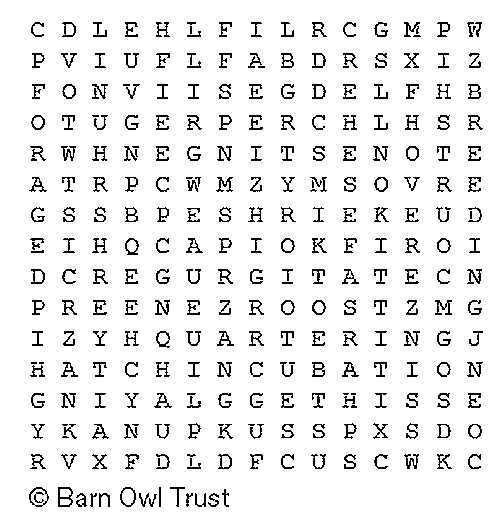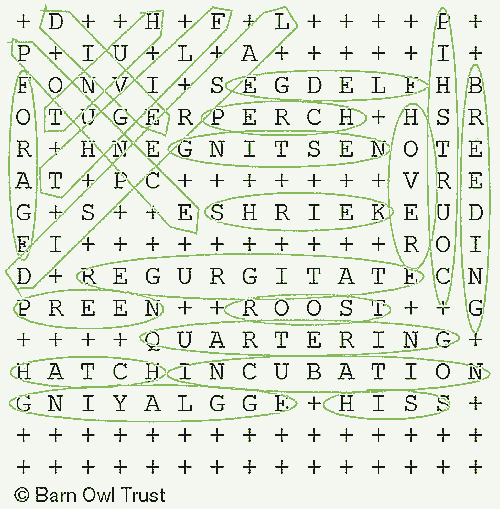What do Barn Owls do all day?
Adult Barn Owls spend an awful lot of time roosting — which means having a doze in a safe, dry, quiet place and really doing nothing very much! The rest of the time they are hunting for food or rearing baby owls. Once they have found enough food and fed their family, it’s time for another snooze!
Baby Barn Owls are very lively – they run, pounce and jump around, playing like kittens! Owlets make hissing noises, click their tongues and move their heads from side to side, round and round, even turning their heads upside down! If you would like to watch them, try tuning into these Barn Owl webcams in the Spring time – if you are very lucky you might even see them learning to fly!
Barn Owl wordsearch puzzle – Find these words:
 How many words can you find to describe Barn Owl behaviour?
How many words can you find to describe Barn Owl behaviour?
Look carefully in the Barn Owl wordsearch puzzle and draw a circle around all the words you can find—they can go down or across, diagonally and even backwards!
Here are all 21 of the words in the Barn Owl wordsearch – along with the Barn Owl behaviour that they describe.
BREEDING – Producing young.
COURTSHIP – Male Barn Owls bring gifts of food to their mates, they ‘play’, rub cheeks and make chattering noises together.
DISPERSAL – When young Barn Owls are old enough, they leave the nest and look for somewhere of their own to live.
DIVE – When a Barn Owl spots a vole it swoops down to catch it.
EGGLAYING – Female Barn Owls usually lay 5 or 6 eggs in spring.
![2 fledgling Barn Owls [Kevin Keatley] Barn Owl Fledglings Kevin Keatley 02](/wp-content/uploads/Barn-Owl-fledglings_Kevin-Keatley-02-250x188.jpg) FLEDGE – When a young Barn Owl’s feathers have grown, it learns to fly.
FLEDGE – When a young Barn Owl’s feathers have grown, it learns to fly.
FLIGHT – A Barn Owl’s flight is silent, because of its very soft feathers.
FORAGE – Search for food. A Barn Owl’s survival is dependent on having good foraging habitat with plenty of voles.
HATCH – Baby Barn Owls hatch out of their eggs about 1 month after being laid.
HISS – As well as screeching, Barn Owls sometimes make hissing and snoring noises.
![A Barn Owl hunting [Nick Sampford] Barn Owls Flying Hunting 06](/wp-content/uploads/Barn-owls-flying-hunting-06-250x188.jpg) HOVER – Barn Owls are able to hover – stay up in the air while keeping still in one place – because they have large wings supporting a lightweight body.
HOVER – Barn Owls are able to hover – stay up in the air while keeping still in one place – because they have large wings supporting a lightweight body.
HUNT – Barn Owls have some amazing adaptations to help them look for and catch prey.
INCUBATION – Sitting on their eggs, keeping them warm until they hatch. Barn Owls begin incubation as soon as the first egg is laid and lay another egg every 2 or 3 days.
NESTING – Barn Owls don’t build a nest – their favourite nesting place to lay their eggs is a ledge hidden away high up in the corner of a barn – or a special wooden nestbox.
![A Barn Owl perched on a post [Nick Sampford] Barn Owls Perched Hunting 06](/wp-content/uploads/Barn-Owls-perched-hunting-06-250x188.jpg) PERCH – Barn Owls sometimes like to stand on a fence post and watch for voles or mice to catch. Perch can mean the way the owl stands and also the place where it stands.
PERCH – Barn Owls sometimes like to stand on a fence post and watch for voles or mice to catch. Perch can mean the way the owl stands and also the place where it stands.
POUNCE – When a Barn Owl sees its prey it jumps on it with its long legs and sharp talons.
PREEN – Barn Owls – like all birds – keep themselves clean and tidy by smoothing their feathers with their beaks.
QUARTERING – Barn Owls often hunt by methodically searching an area by flying over it, back and forth.
![Barn Owl carrying its prey [Ed Mackerrow] American Barn Owl Flying With Prey Ed Mackerrow](/wp-content/uploads/american-barn-owl_flying-with-prey-ed-mackerrow-250x188.jpg) REGURGITATE – Barn Owls cough up – regurgitate – their pellets through their beaks.
REGURGITATE – Barn Owls cough up – regurgitate – their pellets through their beaks.
ROOST – Resting – or a place for resting – somewhere quiet and out of sight.
SHRIEK – Barn Owls screech or shriek – they never hoot (that’s Tawny Owls).
Here's the Solution for the Wordsearch Puzzle - Click to open
* Printable puzzle pages available free for personal and educational use only.
To Print: Click the green Print button at the top of the page.







